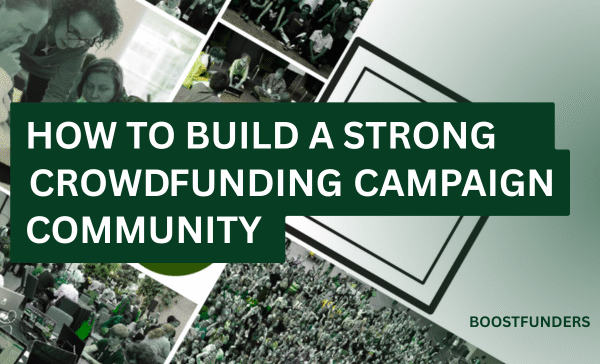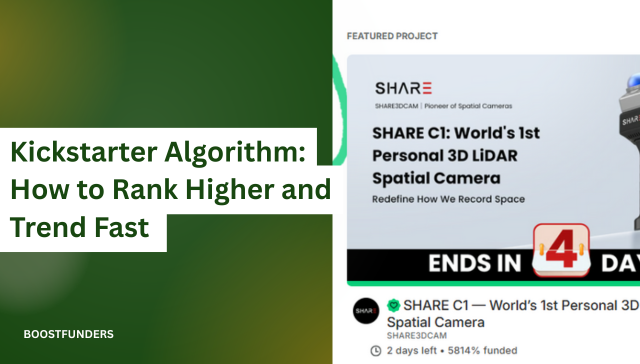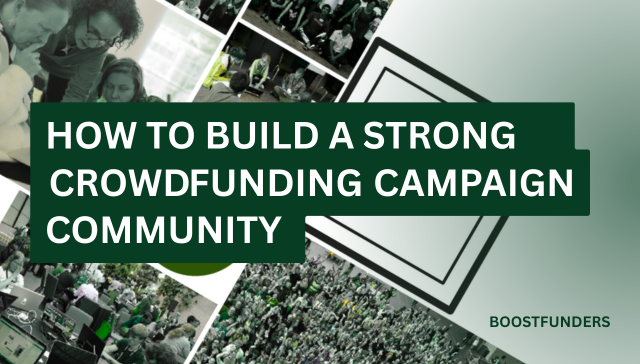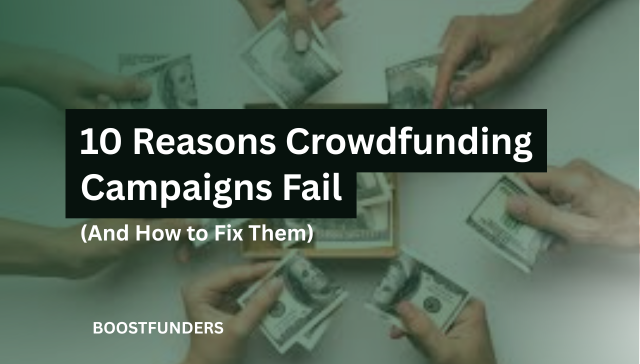How To Use Crowdfunding To Test And Validate Product-Market Fit
 I hope you find this blog helpful as you plan your crowdfunding journey. If you’d like personalized support or expert guidance to help make your campaign a success, click here
I hope you find this blog helpful as you plan your crowdfunding journey. If you’d like personalized support or expert guidance to help make your campaign a success, click here
Author: Adebayo Ogungbemile | Founder of Boostfunders
Crowdfunding is no longer just a way to raise money; it’s one of the most powerful tools for testing and validating product–market fit before committing to large-scale production or marketing spend.
Unlike traditional market research, crowdfunding forces real behavior. People don’t just say they like your idea, they prove it with their wallets. Backers vote with money, feedback, and engagement, giving founders immediate insight into whether a product truly resonates with its target audience.
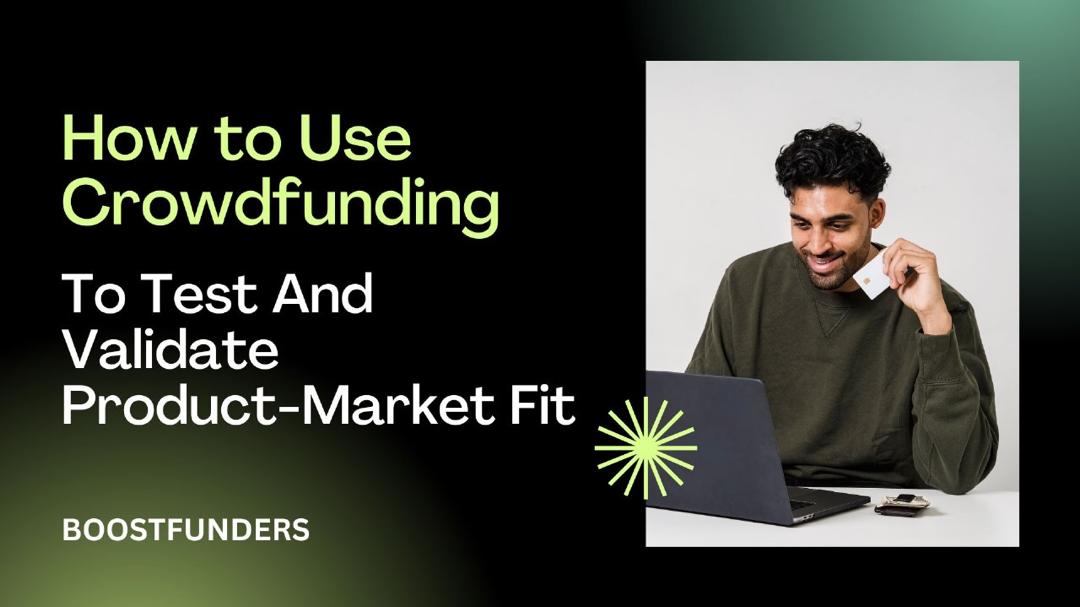
In this guide, we’ll break down how to use crowdfunding strategically to validate demand, pricing, messaging, and positioning long before you scale. When done correctly, a successful crowdfunding campaign doesn’t just fund your product; it confirms you’re building something the market actually wants.
KEY TAKEAWAYS
-
Crowdfunding is real market validation, not speculation
Unlike surveys or focus groups, crowdfunding measures actual buying intent. If people are willing to back your campaign, you’ve validated demand in the strongest way possible. -
Product–market fit shows up early in campaign behavior
Fast early funding, strong conversion rates, repeat sharing, and organic traffic are all signals that your product resonates with a real audience. -
Messaging and positioning can be tested in real time
Headlines, visuals, pricing tiers, and value propositions can be adjusted during prelaunch and early live phases to see what converts best. -
Pricing validation happens naturally on crowdfunding platforms
If backers hesitate, downgrade, or abandon pledges, it often indicates pricing friction not lack of interest allowing founders to refine offers before scaling. -
Crowdfunding reduces risk before mass production
By validating demand first, founders avoid costly inventory mistakes and can confidently move forward knowing the market response is proven. -
Expert guidance accelerates validation
Working with experienced agencies like Boostfunders helps founders structure campaigns to capture cleaner data, stronger signals, and faster validation.
Ready to launch your product? Great, but did you know that 42% of innovations failed because there’s no market need for their product? That is why product testing with the market is important before you get the products into the market for sale.
What is Product-Market Fit?
Product-market fit is the way of measuring or knowing the demand of the market for a product and the needs of a targeted audience. It simply means creating something that people are willing to pay for. This is the first factor that will determine the success of your product and its sustainability in a competitive market.
Why does product-market fit matter?
Achieving product-market fit is important for startups for several reasons. It ensures that your product solves a real problem or fulfills a genuine need for your target audience. Without it, even the best marketing efforts or innovative designs can fall flat. Here’s why it matters
- Customer retention and loyalty
- Pricing power
- Efficient use of resources
- Referrals and organic growth
- Long-term success
Without product-market fit, you risk launching a product that struggles to gain traction, leading to frustration, financial loss, and even failure.
Using Crowdfunding To Test Product-Market Fit
Crowdfunding isn’t just about raising money. It’s a powerful tool for validating your ideas and testing product-market fit. By putting your product in front of real people, you gain valuable insights into demand, customer preferences, and market readiness, all before fully committing to production. As you already know, crowdfunding is a way of raising money online for business, personal, or charity purposes. And there are many crowdfunding platforms where you can set up your campaign and raise funds such as Kickstarter, Indiegogo, GoFundMe, Wefunder, and others.
Crowdfunding platforms like Kickstarter and Indiegogo have been instrumental for entrepreneurs to test product-market fit. Some notable campaigns utilized crowdfunding for market validation:
-
Fidget Cube
The Fidget Cube, a desk toy designed to help individuals focus, launched on Kickstarter with a modest goal but raised over $6 million from over 154,000 backers. This overwhelming response validated the product’s market fit, demonstrating significant demand for such a device.
- Coolest Cooler
The Coolest Cooler, an all-in-one cooler with various features, sought to test its market appeal through Kickstarter. The campaign raised over $13 million, indicating a high demand. However, despite the successful funding, the company faced challenges in production and fulfillment, highlighting that while crowdfunding can validate market interest, execution remains critical.
Steps involved in using crowdfunding for Product-market fit
- Define Your Target Audience
- Create a Minimum Viable Product (MVP)
- Set Clear Campaign Goals
- Engage Your Audience
- Analyze Results During and After the Campaign
- Avoid Common Mistakes
- Define Your Target Audience
To understand your audience, you’ll need to research your audience and identify who your ideal customers are.
Key factors to consider
- Survey
Surveys are highly underrated. They give you tons of data you can use to define your target audience as long as you prepare effective questions. To get you started, you might ask questions like these:
- Who are my customers?
- How can I effectively reach them?
- What price are they willing to pay for these offerings?
- Lastly, who are the competitors they might be considering?
- What social media sites do you spend the most time on?
- Use the answers to your survey questions to build buyer personas, then create a crowdfunding pre-launch page, emails, and other marketing assets
- Social Media Insight
By combining social media insights and market research, you can accurately define your audience’s demographics and psychographics, ensuring your messaging and product resonate with the right people.
Social media platforms like Facebook, Instagram, LinkedIn, and Twitter provide invaluable data about your audience.
Consider the following points;
Audience Analytics: Review the demographics of your current followers, including their age, gender, and location. Tools like Facebook Audience Insights or Instagram’s Professional Dashboard offer detailed breakdowns.
Engagement Metrics: Look at which posts generate the most likes, comments, and shares. This helps you understand what type of content or messaging resonates most.
Hashtag Performance: Monitor hashtags relevant to your industry or product to identify trends and understand what your target audience cares about.
3. Market Research to Define Demographics
Demographics provide a factual understanding of your potential audience.
Key factors;
- Age: Are you targeting Gen Z, Millennials, Gen X, or Baby Boomers? Each group has distinct purchasing behaviors.
- Location: Where does your audience live? Knowing this can help you localize your campaign or understand logistical constraints like shipping.
- Income Level: Can your audience afford your product or service? This is crucial for pricing strategy.
- Education Level: This may influence how you frame your product benefits and messaging.
How to Gather Data:
- Surveys and Polls: Ask direct questions about demographics and preferences. Tools like Google Forms or SurveyMonkey can help.
- Competitor Analysis: Review similar campaigns or businesses to see who engages with their content.
- Market Research to Define Psychographics
Psychographics go beyond demographics by exploring your audience’s behavior, values, and challenges.
Key factors:
- Interests: What hobbies, passions, or causes resonate with them?
- Challenges: What problems do they face that your product can solve?
- Buying Habits: Are they impulsive buyers or need convincing with detailed product information?
How to Gather Data:
- Focus Groups: Have detailed discussions with a small group of potential users.
- Social Listening: Monitor discussions about your industry or product on forums, Reddit, and social media.
By combining social media insights with detailed market research, you gain a holistic view of your audience.
This allows you to:
- Tailor your crowdfunding campaign to their preferences.
- Create targeted ads that resonate.
- Develop a product that truly solves their problems.
Example
The creators of the Fidget Cube used social media to monitor trends in stress relief gadgets and ran surveys to identify their audience’s biggest stress-related challenges. By combining this data, they created a product that directly addressed their audience’s needs, resulting in over $6.4 million raised on Kickstarter.
2. Create a Minimum Viable Product (MVP)
The minimum viable product, or MVP, is the simplest version of a product that you need to build to sell to a market. The version of a new product that allows a team to collect the maximum amount of validated learning about customers with the least effort.
Market research to develop an MVP can include:
- Competitive analysis
- Opportunity and SWOT analysis
- Surveys
Why is an MVP Crucial for Crowdfunding?
- Validates Product-Market Fit: An MVP allows you to test your idea with real users before investing heavily in full-scale production.
- Attracts Backers: A functional prototype or simplified version of your product reassures potential backers of its feasibility.
- Guides Iteration: Feedback from the MVP helps you refine your product based on what the audience values most.
- Demonstrates Credibility: Having an MVP shows backers you’ve moved beyond the idea stage and are serious about delivering results.
Steps to Create an MVP for your Crowdfunding Campaign:
- Define the Core Problem Your Product Solves
- Identify Essential Features
- Build a Prototype of your product to showcase doing a crowdfunding campaign
- Test the MVP with a group of users
- Refine based on feedback and add features that backers requested
To showcase an MVP in your crowdfunding campaign, follow the steps:
- Create a demonstration video: Show the MVP in action to highlight its core functionality.
- Explain Its Purpose: Communicate how the MVP solves a specific problem and why it’s valuable.
- Include Testimonials: Early users who tested your MVP can provide social proof.
3. Set Clear Campaign Goals
Setting the right goal for your crowdfunding campaign is one of the major factor that will determine the success of your campaign. Consider the following steps to implement effective goals for your campaign:
- Financial Goals
You need to ask yourself the question about how much you need. Determine the exact amount of money you to bring your project to life. Break down your funding target into categories like production costs, marketing expenses, shipping, and platform fees.
We have some crowdfunding platforms like Kickstarter and Indiegogo with features that enable the creators to calculate their funding goals. Using Kickstarter as a case study;
Kickstarter runs on an all-or-nothing funding model, meaning that unless a campaign reaches its funding goal, backers are not charged, and creators receive no funds. Therefore, setting the right funding goal is crucial for a successful campaign and project completion. According to Kickstarter, here are the steps to consider in setting the right goal for your campaign.
- List All Costs
- Estimate and Research
- Account for Fees
- Consider Taxes
Kickstarter also has the features of a funding calculator which can help you visualize potential costs, including fees and taxes, needed to bring your project to life.
2. Community Goals: Building a Loyal Support Base
A strong and engaged community is the backbone of any successful crowdfunding campaign. Your supporters are more than just backers—they’re advocates for your product and brand. Fostering this connection during the pre-launch phase can significantly impact your campaign’s performance.
Here’s how to effectively build and engage a loyal support base:
- Start with a pre-launch campaign
You can launch a pre-launch campaign on any crowdfunding platform such as Kickstarter or Indiegogo. Launching a pre-launch campaign will enable you to share the vital information necessary to start building hype for your campaign and present a direct call to action for potential backers to be notified when your project has launched.
Running a pre-launch campaign plays a crucial role in determining crowdfunding campaign success. A creator who runs a pre-launch campaign and generates 10K email lists will have more chances of achieving his fundraising goal than someone who did not run a pre-launch campaign at all.
2. Leverage Social Media to Grow Your Community
Social media remains the most powerful tool for connecting with your potential audience. Before launching your crowdfunding campaign on any crowdfunding platform, it’s essential to identify the platform where your audience is most active and likely to engage. Keep in mind that not all social media platforms can be used for promoting your crowdfunding campaign, you can use the strategies outlined in the second section of this blog to understand who your audience is and which platform is the most effective for reaching them. Read more about community building from my previous article.
4. Engage Your Audience
Audience engagement is the heartbeat of a successful crowdfunding campaign. Engaging your audience effectively builds trust, excitement, and loyalty—key factors that turn casual observers into enthusiastic backers. Here’s how to keep your audience interested and involved before, during, and after your campaign.
- Create a Two-Way Dialogue
Crowdfunding thrives on community involvement. Instead of treating your audience as passive supporters, involve them in your journey by doing the following;
- Respond Promptly: Answer questions and acknowledge feedback on social media, email, or campaign platforms.
- Host Live Sessions: Use platforms like Instagram Live, YouTube Live, or Zoom to interact directly with your audience. Share updates, answer questions, and build personal connections.
- Polls and Surveys: Invite your audience to vote on design elements, product features, or reward tiers. This makes them feel like co-creators of your product.
Example: The creators of Coolest Cooler asked their backers to help choose product colors and additional features, creating a sense of ownership among supporters.
Other ways of engaging with your audience are;
- Celebrate Milestones with Backers
- Use Stretch Goals to Maintain Momentum
- Provide Personalized Updates
- Continue Post-Campaign Engagement.
5. Analyze Results During and After the Campaign
Analyzing the performance of your crowdfunding campaign is the most important step to understanding what worked and what didn’t and how to improve future efforts. This process involves examining metrics, gathering feedback, and making data-driven decisions. Consider the following steps to analyze results at every stage.
- During the campaign – Track key performance metrics
Monitoring metrics throughout your campaign helps you identify trends and make adjustments. Here are the metrics to monitor:
- Pledge Velocity
- Conversion rate
- Engagement Metrics
- Traffic Sources
Some tools to use are:
- Kickstarter Dashboard
- Google Analytics
- After the Campaign: Evaluate Overall Success
Once your campaign ends, dive deeper into the data to evaluate its performance.
- Funding Achieved
- Backer Demographics
- Pledge Levels
- Conversion Rates
Gather Backer Feedback
- Send Surveys
- Monitor Comments.
Analyzing results during and after your campaign is vital for maximizing the success of future efforts.
6. Avoid Common Mistakes
While crowdfunding is a powerful tool to validate your product-market fit, some pitfalls can derail your efforts. Avoid these common mistakes to ensure your campaign achieves its objectives:
- Neglecting Pre-Launch Preparation
- Setting Unrealistic Goals
- Poorly Defined Target Audience
- Offering Weak or Confusing Rewards
- Failing to Engage Backers
- Lack of budget for campaign promotion
- Mismanaging Campaign Funds
- Ignoring Post-Campaign Engagement
- Overpromising and Under-Delivering
- Not Learning from Failure
Avoiding these common mistakes will increase your chances of crowdfunding success while effectively testing your product-market fit.
Conclusion
Crowdfunding isn’t just a way to raise funds, it’s a powerful method to test and validate your product-market fit. By defining your target audience, launching a minimum viable product (MVP), setting clear goals, building a community, and analyzing results, you can gain valuable insights to refine your product and marketing strategy.
Whether you’re using Kickstarter, Indiegogo, or other platforms, a well-executed crowdfunding campaign can serve as a springboard for your product’s success in the market. Remember, the journey doesn’t end with funding. Use the momentum from your campaign to establish a loyal customer base and prepare for future launches.
Recent Comments
Categories
- Business (2)
- Crowdfunding Strategy (7)
- Equity Crowdfunding Tips & Strategy (3)
- Fashion (2)
- LifeStyle (1)
- Movies (1)
- Restaurant (1)
- Technology (1)
FAQs
Building a community is crucial because it provides a strong foundation of early supporters who are more likely to back or support your project. A dedicated community creates momentum when your campaign launches, making it more visible to a wider audience and increasing your chances of success.
Start by defining your project’s niche and understanding who would be most interested in it. Research the demographics, interests, and online behaviors of your potential supporters. Use tools like Google Analytics, and surveys to gather data about your audience.
The best platforms depend on your target audience. Visual projects may perform well on Instagram and TikTok, while business or professional services might thrive on LinkedIn. For gaming or tech projects, platforms like Discord or Twitch will be fine. Consider where your audience is most active and engaged.
Engage your community by sharing behind-the-scenes content, project updates, and teasers. Use email newsletters, social media posts, and blog updates to build excitement and anticipation. Encourage feedback and make your audience feel like they’re part of the process.
Yes, collaborating with micro or macro influencers who align with your niche can help increase exposure and credibility. Influencers can introduce your project to a broader audience, and their endorsement can build trust within their communities, helping drive early support for your campaign.
Regular updates are key. Share progress, milestones, new rewards, and stretch goals with your supporters.
Recommended, you should start building your community 3-5 months before your campaign launches. This gives you enough time to nurture relationships, create excitement, and gather feedback. Early engagement also helps you build trust, which is crucial for a successful launch.
Email marketing allows you to directly communicate with your audience. You can use it to provide regular updates, share exclusive content, and offer early-bird rewards. Email subscribers are often more invested and engaged, making them more likely to support your campaign when it goes live.
Continue to provide updates on your project’s progress, even after the campaign has ended. Keep your backers informed about production and delivery timelines. Share stories of how their support is making a difference, and create opportunities for them to stay involved, such as through post-campaign surveys or follow-up projects.
You can reach out to the Boostfunders team. We specialize in crowdfunding campaign management and community building and will be happy to assist with everything from strategy to execution for your campaign’s success.

